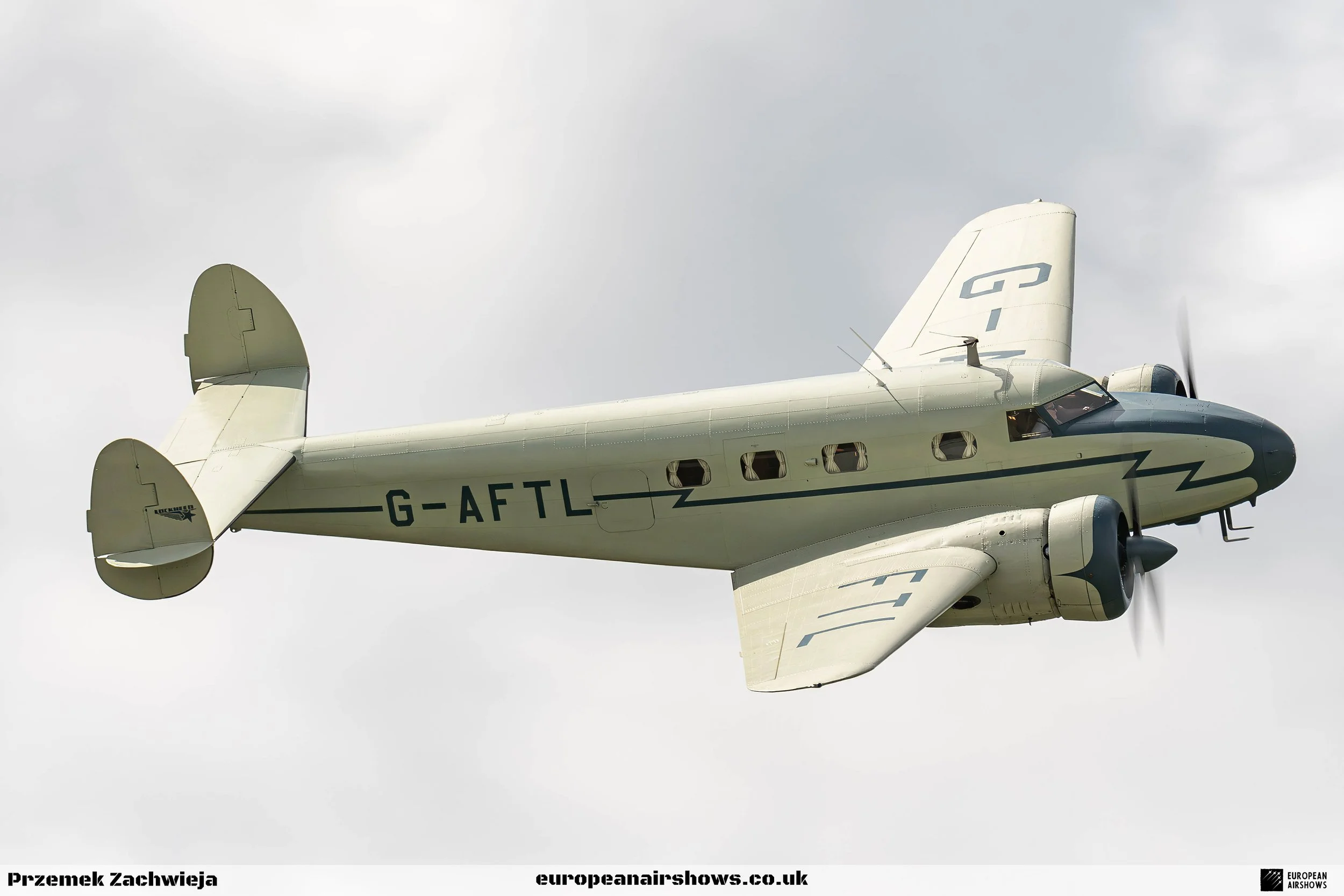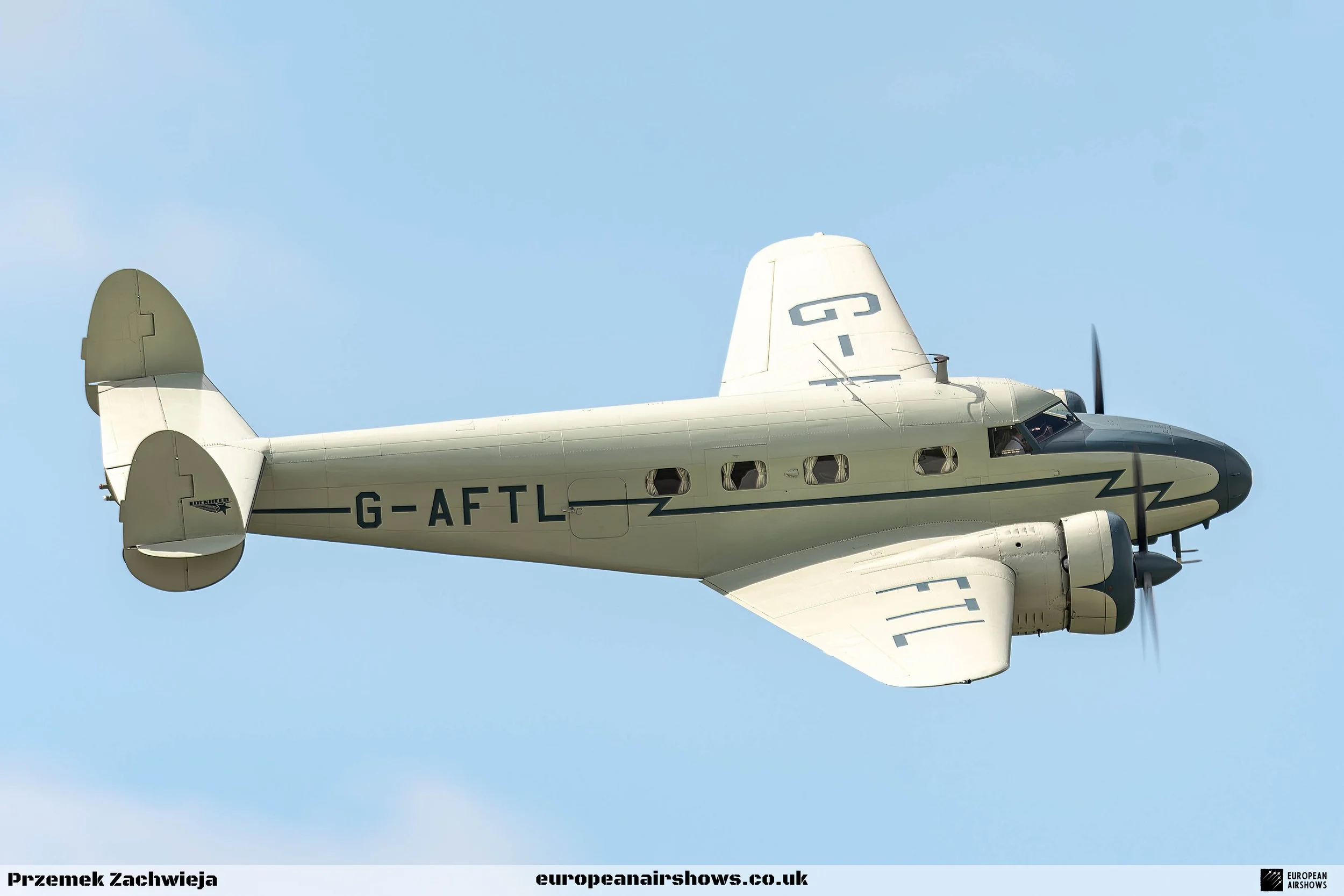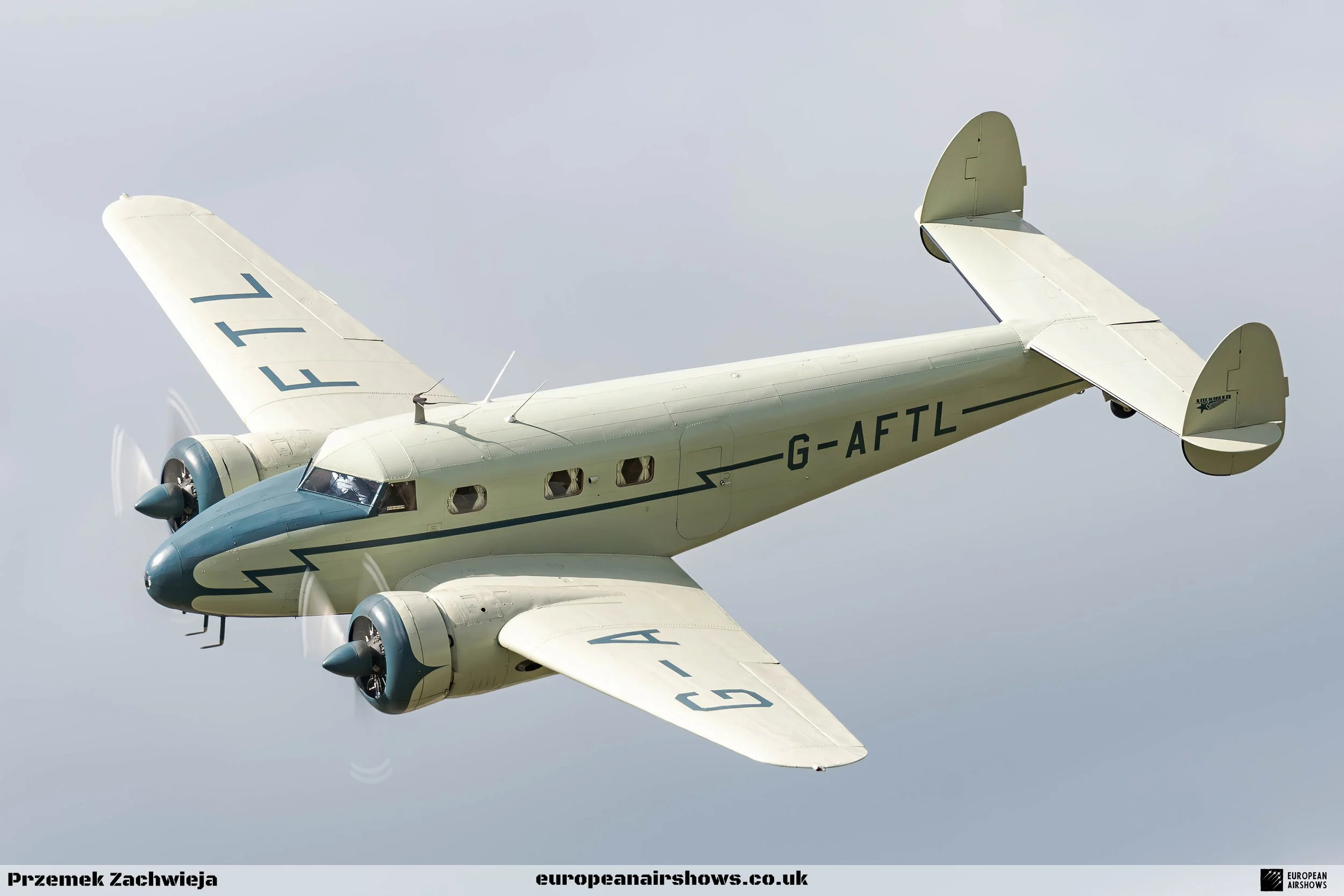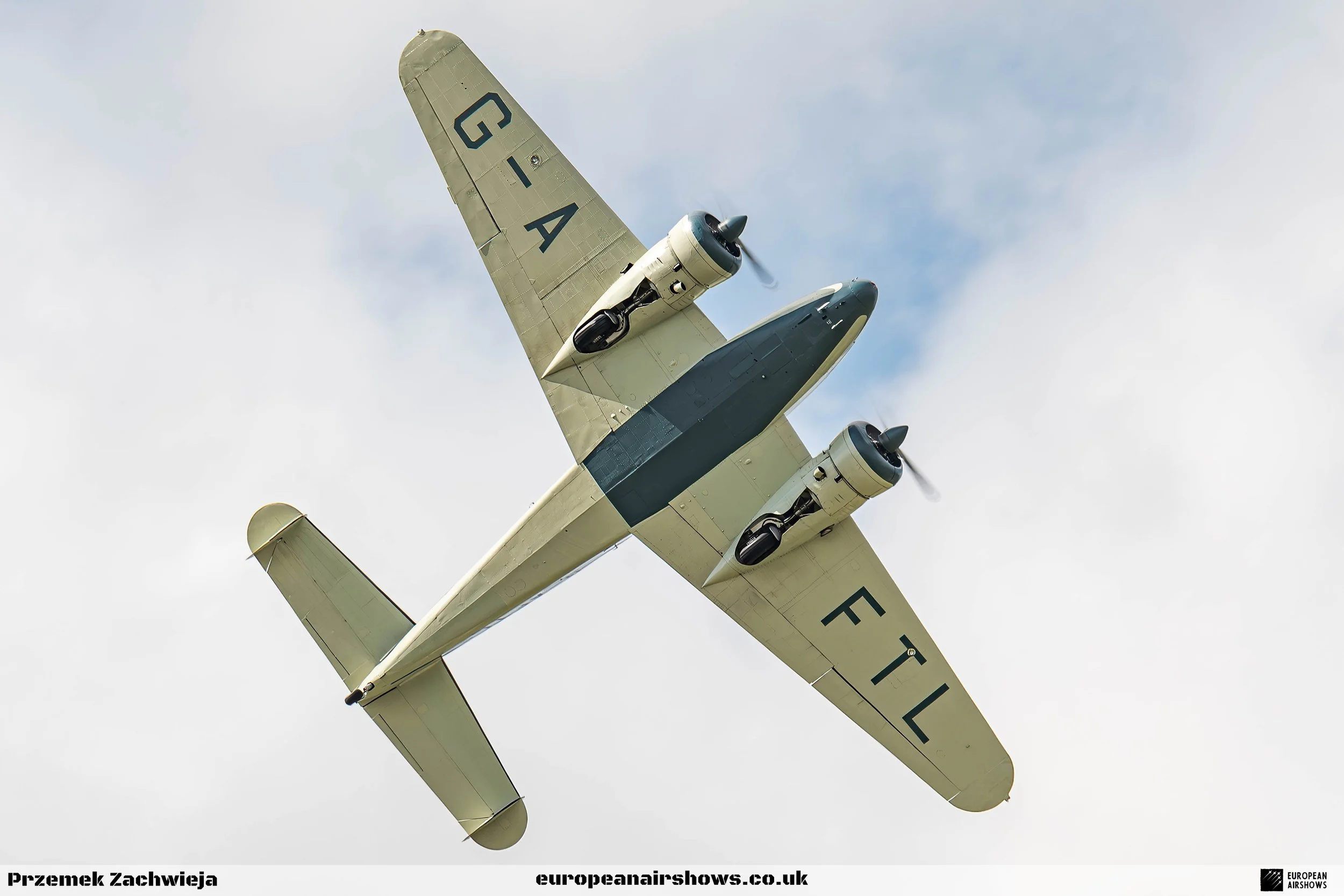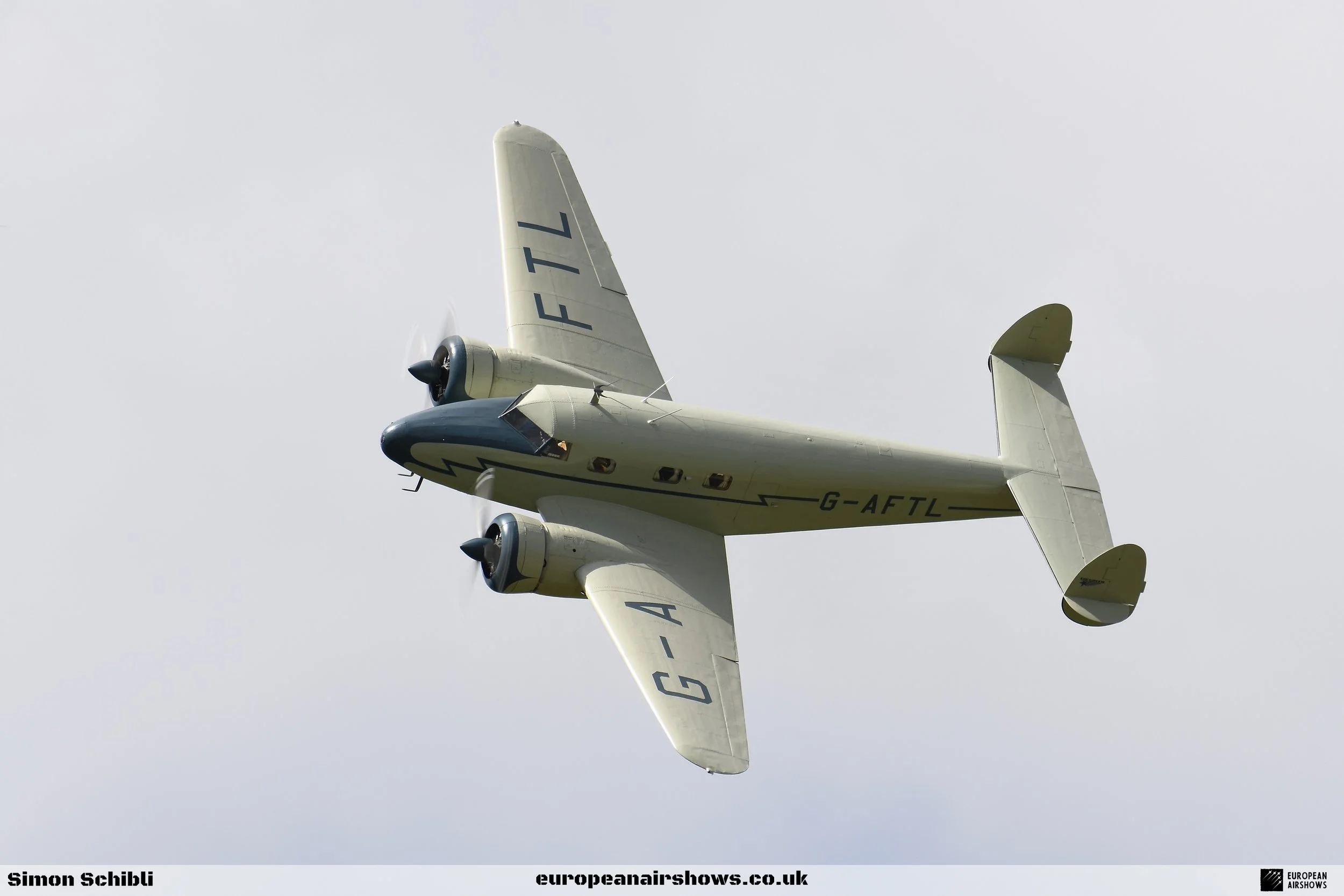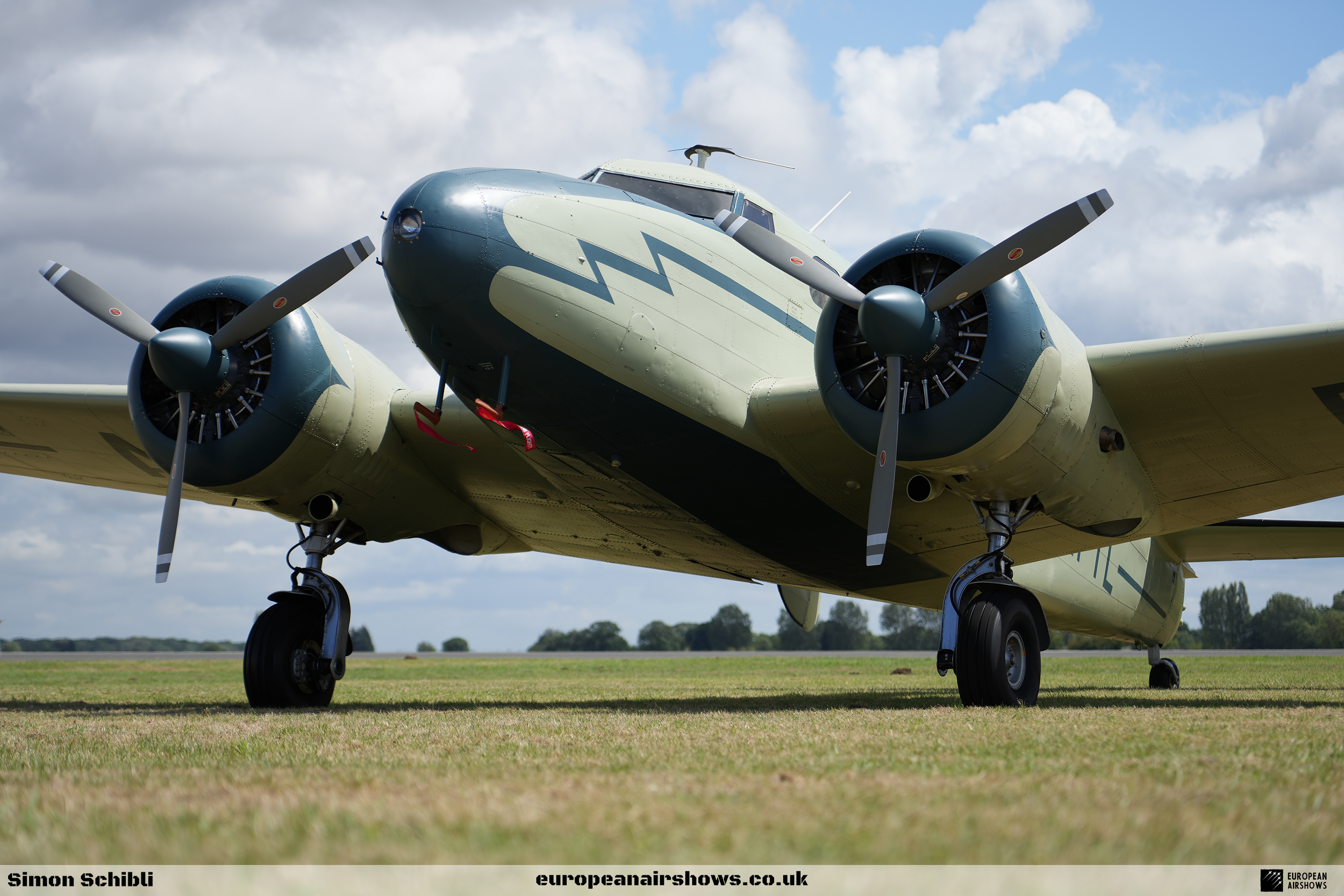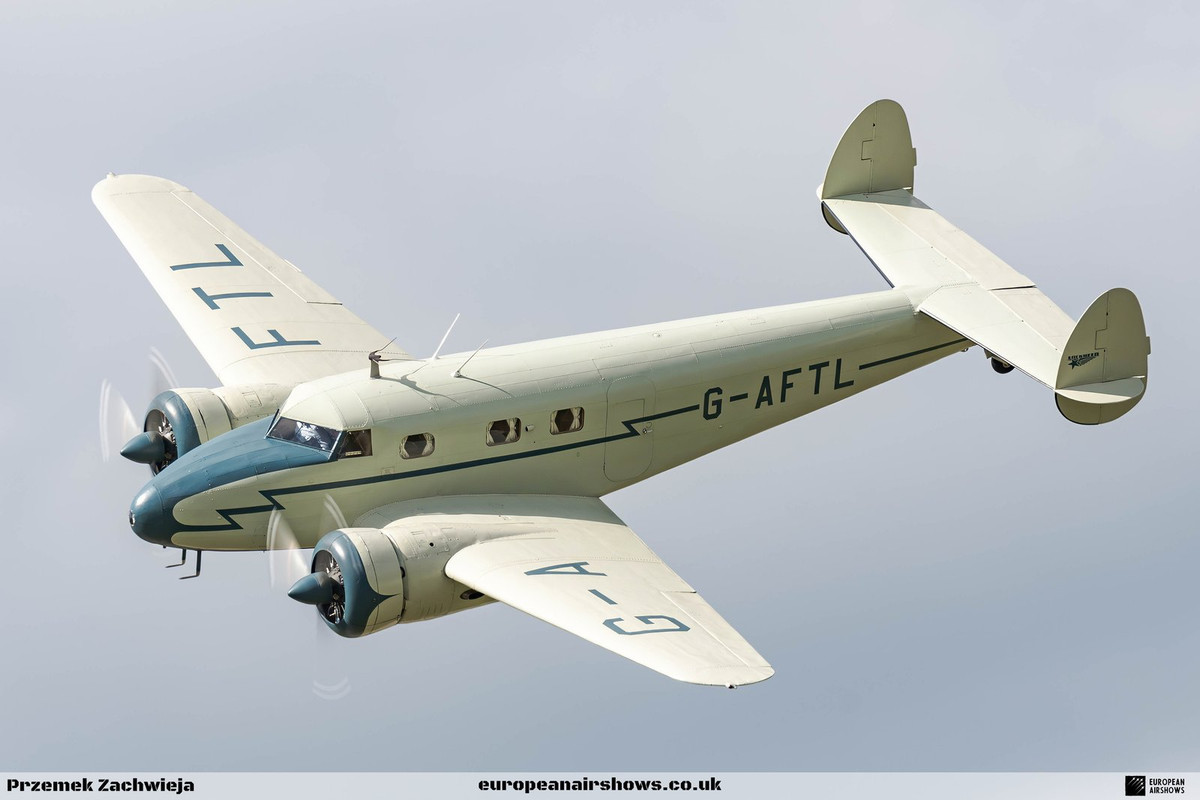
Electra Junior G-AFTL
About the Electra Junior
The Lockheed Model 12 Electra Junior, more commonly known as the Lockheed 12 or L-12, emerged in the late 1930s as an eight-seat, twin-engine transport aircraft designed primarily for small airlines, corporate executives, and government officials. Developed as a compact version of the larger Model 10 Electra, the Electra Junior was born out of both market demand and a government competition aimed at creating a feeder airliner. Lockheed’s design cleverly scaled down the Electra while retaining advanced features such as all-metal construction, low-drag NACA cowlings, and the distinctive twin tail fins that would become synonymous with the company’s designs. With its impressive performance marked by a top speed of 225 mph at 5,000 feet, the aircraft blended innovation and practicality, flying just in time to win the competition almost by default.
Although intended to serve as a feeder airliner, the Electra Junior found its true calling in the realm of corporate and government transport rather than in regular commercial routes. Few airlines opted for the Lockheed 12 as their primary airliner, despite early adopters like Continental Air Lines establishing routes in the American Southwest and the Caribbean-based British West Indian Airways operating flights between remote islands. Instead, wealthier private owners and large corporations embraced the Model 12 for its refined cabin layouts and efficient performance. Its versatility did not stop there; the aircraft also became a favored platform for testing emerging aviation technologies. From experimental deicing systems and tricycle landing gear modifications to adaptations for carrier landing trials carried out by the U.S. Navy, the Electra Junior proved to be much more than a simple passenger plane.
Throughout its production life, which saw 130 examples built before production ended in 1941, the Lockheed 12 built an enduring legacy as an adaptable and reliable workhorse of the skies. During World War II, numerous civilian aircraft were requisitioned for military duties by several nations, while modifications even allowed a version to serve as a bomber trainer for the Royal Netherlands East Indies Army Air Force. The aircraft also gained a place in aviation lore through daring feats in endurance races and covert reconnaissance missions, including those flown by Sidney Cotton over European military installations in the tense months preceding wartime. Today, a number of Lockheed 12s still survive, cherished by private collectors and historic aviation enthusiasts alike, and they continue to capture the imagination as symbols of an era when rapid innovation and daring ambition defined the skies.
Specifications
Crew
2
Length
36 ft 4 in (11.07 m)
Wingspan
49 ft 6 in (15.09 m)
Height
9 ft 9 in (2.97 m)
Max Speed
225 mph (362 km/h, 196 kn)
Range
800 mi (1,300 km, 700 nmi)
Service Ceiling
22,900 ft (7,000 m)
Rate of climb
1,400 ft/min (7.1 m/s)
Lockheed 12A Variant
The Model 12A, the original version of Lockheed’s diminutive twin‐engined transport, emerged as a refined evolution of its larger cousin, the Model 10 Electra. Developed in the mid‑1930s to address a growing need for feeder airliners and corporate transports, the Model 12A retained many of the Electra’s advanced features—its all‐metal construction, low‐drag NACA cowlings, twin tail fins, and retractable main landing gear housed in the engine nacelles—while being scaled down to accommodate six passengers and two pilots. Powered by a pair of 450‑hp Pratt & Whitney R‑985 Wasp Junior SB radial engines, the Model 12A was not just a reduction in size; it was a rethinking of efficiency and speed, capable of reaching a top speed of 225 miles per hour at 5,000 feet.
The aircraft’s first flight on June 27, 1936, was as much a declaration of Lockheed’s commitment to innovation as it was an adroit entry into a government competition that sought a purpose‐built feeder airliner. Arriving just three days before the deadline, the Model 12A effectively became Lockheed’s winning ticket, especially since its competitors were not ready in time for evaluation. Despite its success in the contest, the aircraft found its greatest champions not in the commercial airlines—where its relatively limited capacity and operating economics saw only sporadic use—but rather among private executives, corporate magnates, and government officials who valued its blend of style and performance.
In service, the Model 12A made its mark in diverse and sometimes unexpected ways. It was a platform for aviation extremes: one example was its participation in the 1937 Bendix Trophy Race, where aviator Milo Burcham took advantage of extra fuel tanks to complete a nonstop coast-to-coast flight, proving the aircraft’s impressive capabilities. Another variant of its adventurous spirit was embodied by an aircraft modified for a round-the-world attempt by aviator Jimmie Mattern. Although that particular expedition never took off as planned, it underscored the aircraft’s flexibility and the daring mindset of its era.
With a production run of 70 units, the Model 12A became the cornerstone around which nearly all subsequent Lockheed 12 developments were based. While the aircraft’s direct impact as an airliner was limited, it secured its legacy by powering corporate travel and military transport alike. Its influence extended well into technology testing laboratories; several units served as valuable testbeds for innovations such as deicing systems and alternative landing gear configurations.
Did You Know?
- The Lockheed Model 12 Electra Junior is also known simply as the Lockheed 12.
- The Lockheed 12 was developed as a smaller version of the Model 10 Electra with only six passengers and two pilots.
- The aircraft used two Pratt & Whitney R-985 Wasp Junior SB radial engines—the same engine type used in its larger sibling.
- The Lockheed 12’s design featured twin tail fins and rudders, which became a Lockheed trademark.
- Lockheed 12A participated in the 1937 Bendix Trophy Race, achieving a mid-race average speed that rivaled fighter aircraft.
Test Your Knowledge
1. How many passengers was the Lockheed 12 initially designed to carry (excluding pilots)?
Electra Junior G-AFTL
Lockheed 12A G-AFTL, an Electra Junior with a checkered past, earned its reputation as one of the most historic photo-reconnaissance aircraft ever to take to the skies. Its story intertwines daring flights, clandestine missions, and a cast of intriguing characters led by Sidney Cotton—a maverick Australian entrepreneur, engineer, and adventurer. Sidney Cotton, a pioneer who had already made his mark during his Royal Naval Air Service days and with his invention of the Sidcot flying suit in 1916, transitioned from seal and game-spotting over Canada to capturing mesmerizing images of America’s National Parks, including the Grand Canyon. By 1938, back in the United Kingdom, Cotton was establishing his aerial survey company Aerofilms out of Heston. However, his expertise soon caught the attention of MI6’s Frederick W. Winterbottom, who recruited him to capture clandestine images of the growing German military might.
Built in 1936, the Lockheed possessed an inherent elegance that belied its later, covert adventures. In May 1939, the aircraft made its transatlantic journey—transported aboard the SS Aquitania—before being meticulously reassembled at Southampton’s Eastleigh Airport by Cunliffe-Owen Aircraft. To better suit its secretive role, the Lockheed traded its natural metallic finish for a subdued green scheme accented in red, and its certificate of registration was filed under British Airways as a clever ruse to obscure its true purpose. Enhancements such as two additional 70-gallon fuel tanks extended its range to an impressive 1,600 miles, while modifications at Airwork in Heston installed hatches beneath the rear fuselage that concealed three F24 cameras activated by a simple button beneath the pilot’s seat.
Under Cotton’s command, the aircraft—dubbed ‘FTL’—embarked on a series of high-stakes reconnaissance sorties. Initially intended for location scouting for his film company, cotton-candy flights turned into daring photographic missions over regions as far-flung as the Middle East and North Africa. By mid-July 1939, modifications to the plane allowed for Leica cameras to hide behind sliding panels in its wings. During a notorious sortie on 26 July, Cotton flew from Heston to Berlin Tempelhof, evading the prescribed flight paths dictated by his German hosts with the charm and audacity for which he was renowned. On one memorable flight, he even found himself sharing the cockpit with the commander of Tempelhof Airport, an excursion that allowed Cotton—and his instrumentality—to capture pivotal views of restricted military establishments, including a secretive flight over the Rhine near Mannheim and detailed imagery of the German fleet anchored at Wilhelmshaven.
The Lockheed’s exploits continued unabated right up until the outbreak of World War II. On 24 August 1939, ‘FTL’ became the last British aircraft to leave Germany, its cameras dutifully recording a tapestry of images during its final overflight from Heston. Its schedule remained fraught with risk; days later, over Heligoland, Sylt, and Wilhelmshaven, Cotton’s meticulous reconnaissance work would help shape the intelligence picture on the eve of war. Just five days before hostilities erupted, Cotton presented the British Air Ministry with photographs gathered along the Dutch coast—a gesture which led to his commissioning into the RAF as an acting wing commander. Tasked with establishing the service’s Photographic Development Unit at Heston, he continued to leverage his beloved Lockheed in what was soon affectionately dubbed ‘the Cotton Club’ by those who witnessed its impact on reconnaissance capabilities.
From critical missions along England’s south coast in April 1940 to daring ventures into occupied France—venturing as far as Marseilles—the aircraft’s operational legacy evolved with every sortie. Even as it remained a civilian aeroplane on paper, its covert modifications and sophisticated camera setups allowed it to deliver strategic reconnaissance invaluable to the RAF. However, history would also etch a note of melancholy into its ongoing saga. After its airworthiness certificate lapsed on 25 August 1940, a tragic twist of fate saw the Lockheed badly damaged at Heston on 19 September when a parachute mine struck the hangar it occupied. This setback led to the aircraft being shipped back to Lockheed’s factory in Burbank, California, for repairs before eventually being sold and re-registered as NX21707.
The Lockheed 12A’s storied journey did not end there. On 27 March 2023, it took to the skies once more from Sywell Aerodrome in the UK, marking a triumphant return after decades of quiet repose—a final flourish in the continuing chronicle of an aircraft that had once flown the thin line between civilian adventure and covert military reconnaissance.



